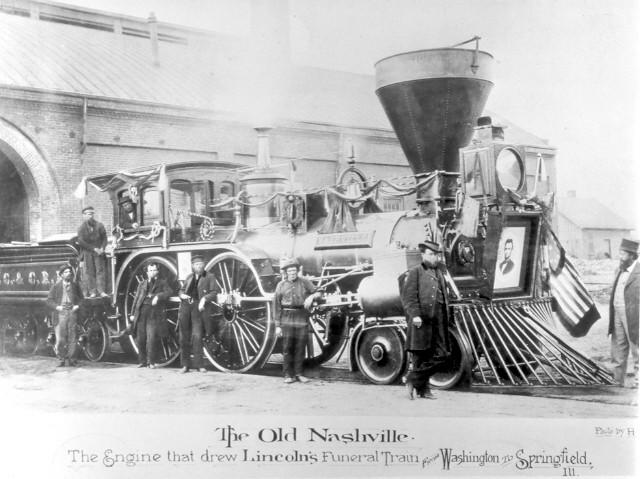- Funeral train
thumb|300px|right|Abraham Lincoln 's funeral train.] A funeral train is atrain specially chartered in order to carry acoffin or coffins to aresting place . Funeral trains today are often reserved for leaders and national heroes, as part of astate funeral , but in the past were sometimes the chief means of transporting coffins and mourners to graveyards. Funeral trains remain mostlysteam locomotive hauled, due to the more romantic image of the steam train against more modern diesel orelectric locomotive s.History
The first funeral train was run by the The London Necropolis and National Mausoleum Company on
7 November 1854 . Trains ran once a day fromLondon Necropolis railway station toBrookwood Cemetery . The train carried not only the bodies of the dead, but the parties of mourners who had come to attend thefuneral services. Different classes were available for both the living and the dead; a more expensive first class ticket would provide a more ornate coffin and greater care of the body during transit. The London Necropolis Company was run byLondon and South Western Railway , who feared that regular passengers would shun locomotives which had previously hauled funeral trains, and therefore purchased an entirely new fleet exclusively for the Necropolis line. The public were initially reserved about the project; one bishop expressed fears that "It may sometimes happen that persons of opposite characters might be carried in the same conveyance. For instance, the body of some profligate spendthrift might be placed in a conveyance with the body of some respectable member of the church, which would shock the feelings of his friends". [http://www.forteantimes.com/articles/179_deathline.shtml The Deathline] - "Fortean Times " (Registration required). URL accessed11 November 2006 ] Others felt that the railway industry, which was less than 20 years old and still very much a new technology, was too hectic and loud, ill-befitting the sombre mourning associated with Christian funeral services.The line ran daily – including Sundays – for almost 50 years until 1900, when the Sunday service was stopped and trains began to run on an "as needed basis". The railway remained in operation through the First World War and Second World War until
16 April 1941 , when the London Necropolis station was bombed in theLondon Blitz . The station was never rebuilt and the line fell into disuse. [ [http://www.tbcs.org.uk/railway.htm The Cemetery Railway] . URL accessed11 November ]Australia
In
Sydney ,Australia , there was a similar service whereby theRookwood Cemetery railway line, Sydney served theRookwood Cemetery complex. From 1867 until 1948 trains would depart Mortuary Station in Sydney City and travel the 15 km to Rookwood Cemetery. [ [http://www.cityrail.info/aboutus/station_tour/location_2.jsp CityRail, Welcome to Central Station] ]In
Melbourne funeral services operated to the Springvale Necropolis along the dedicated Spring Vale Cemetery railway, [cite web
url=http://www.necropolis.net.au/springvale/content/view/143/175/
title=Our Beginnings - Welcome to Springvale Botanical Cemetery
publisher=www.necropolis.net.au
accessdate=2008-08-16] while the Fawkner Cemetery was served by trains to Fawkner station. [cite web
url=http://www.fcmp.com.au/histrain.asp
title=Fawkner Crematorium & Memorial Park : Restored Mortuary Carriage
publisher=www.fcmp.com.au
accessdate=2008-08-24]tate funerals
Although most funeral services now make use of road-going
hearse s rather than trains, funeral trains remain common for the funerals of heads of state; all British monarchs since Queen Victoria have been carried by funeral trains; King Edward VII and King George VI were both taken to theWindsor and Eton Central railway station for the funeral procession. Most British Prime Ministers do not receive funeral trains. However, as part of his state funeral,Winston Churchill 's coffin was carried by an SR "Battle of Britain" Class locomotive "Winston Churchill" toBlenheim Palace . [ [http://www.transportbritain.co.uk/churchill%20project.html The Churchill Project Appeal] . URL accessed11 November 2006 ] Presidents of the United States are also sometimes transported by train;Abraham Lincoln ,Franklin D. Roosevelt , andDwight D. Eisenhower were all given funeral trains as part of the procession.Canadian Prime Minister SirJohn Alexander Macdonald ,John George Diefenbaker andPierre Elliot Trudeau had their bodies transported by train.On
January 23 1924 body ofVladimir Lenin was carried by funeral train toPaveletsky Rail Terminal inMoscow . LaterMuseum of Lenin Funeral train was established in the rail terminal building. [ [http://www.ruzgd.ru/U_127.shtml Мемориальный паровоз У-127] ru icon. URL accessed30 August 2007 ]Gallery
References
External links
* [http://www.teachingheritage.nsw.edu.au/c_building/wlocality9_2_ochert.html The Mortuary Train to Rookwood - A Recollection of the Mortuary Train]
* [http://members.aol.com/RVSNorton1/Lincoln51.html The Route of Abraham Lincoln's Funeral Train]
* [http://investigator.records.nsw.gov.au/asp/photosearch/search.asp?subject=Mortuary%20Railway%20Station%20(NSW)&B1=Search State Records New South Wales - Images of Mortuary Station]
Wikimedia Foundation. 2010.

